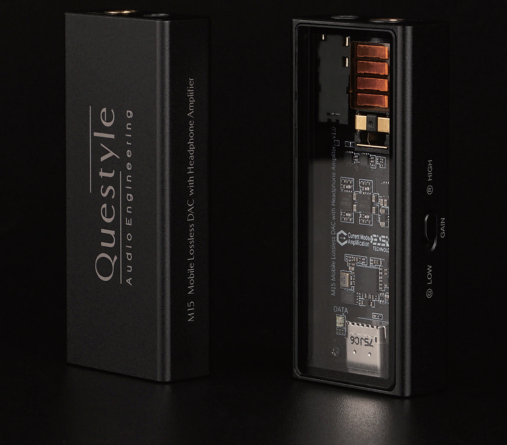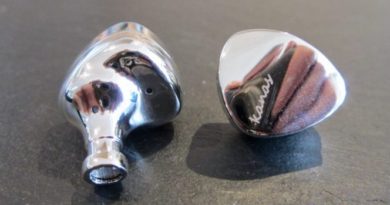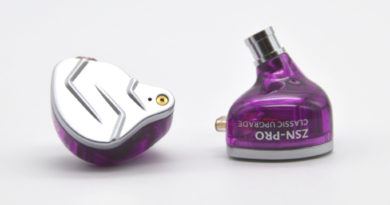Questyle M15 Review (2) – Best In Slot
After a very unfortunate first try (the review unit which was kindfully sent to me by the manufacturer was stolen at my door), I finally got an M15 unit which I quite oddly found for a very good price 2nd hand in Japan. This second package reached me regularly so I can finally assess this device which already collected convinced cobloggers’ praises.
As there already is a comprehensive article about M15 on our blog, I will entirely skip a general description of the device features as it would be needless repetition. I will also be succint on most sound impressions.
I’m going to focus on some detail which are not covered in the previous piece, and/or on aspects for which I have a different opinion.
M15 costs € 249 + freight on the manufacturer’s website.
In this Article
At-a-glance Card
| PROs | CONs |
| Balanced output: outstanding spatial reconstruction, spectacular instrument separation, great imaging, bilaterally extended, dynamic, powerful sound | Single ended output: dull, compressed, underwhelming |
| Elegant, warm-ish musicality | Modest accent on midbass is a step away from tonal neutrality (some may find this not a con). |
| Well implemented High Gain option | Easily picks up RFI when paired to a 4G-connected phone |
| MQA full decoder (MQA fanbois can rejoyce) | No ASIO driver. No Direct DSD output support on Windows |
| Moderate host power consumption | Not fully supported by ALSA. No Direct DSD output support by Roon on Linux, either |
| Modest price for this sound quality |
Miscellaneous good stuff and caveats
Good High Gain option
Unlike what happens on so many other devices I heard, M15’s High Gain option is not chastising in terms of dynamic range compression. The effect is indeed very modest, which makes HG a totally viable option whenever one feels like adding some more early juice delivery to one or another driver.
Bad Single Ended output
It is so obviously duller and noisier compared to the Balanced option to be totally unworthy of such an otherwise outstanding product. To give a vague idea, it’s roughly on quality level of M15’s cheaper (120€) sibling, the M12 – which quality, at that price level, is trounced by the like of E1DA 9038D.
This means that one cannot elect the M15 as its “only” dongle if he/she has one or more drivers with single ended connections to support. Too bad.
Spectacular sound, if not totally uncolored
M15’s sound is first of all grand (spatially), and immediately after that it’s clear and detailed. Instrument separation and layering are just spectacular – which paired with its space drawing capabilities make for a really uncommonly good imaging and “sense of immersion” into the outcoming sound.
M15 is not uncolored in terms of tonality. There is some added accent on midbass notes – which is if you wish part of the “usual” compromise “musicality vs purity”. The situation comes out obvious when comparing M15 with E1DA 9038SG3: the two offer equal bilaterally extended sound ranges, with the latter’s bass staying faster, “more technical”, therefore also “less expressive” in a sense.
9038SG3 is however a step under M15 in terms of spatial reconstruction, with particular regards to depth. Layering is also a bit less refined – and that’s mainly why M15 comes across overall “more musically pleasing” compared to 9038SG3.
Powerwise 9038SG3 is better vs very low impedances: in the E5000-acidtest 9038SG3 beats M15 in terms of bass control and overall clarity. It’s fair to observe that 9038SG3 remains the best option around, and by far so, when the available budget is like half M15’s asking price.
In its being “exquisitely musical if unpure” M15 can’t but recall Groove in a sense. In Apogee’s dongle case sound colouring is even more marked, and comes with furtherly higher capability in terms of stage drawing – depth and height most of all. The two devices are not effectively comparable though – mainly due to Groove’s internal architecture making it the odd ball it is – read my piece for the full reasons why.
Annoying RFI sensitivity
When paired to a smartphone connected to the 4G cell network M15 easily picks up RFI (Radio Frequency Interference) when within approx 10cm from the phone. The “solution” is using a non-ultrashort USB-C cable for the connection, but a problem still remains when you walk around with your phone + the M15 in a coat’s pocket…
By comparison, E1DA 9038D behaves very similarly, E1DA 9038SG3 is instead virtually immune to such RFI.
Oddly lacking Direct-DSD support on non-mobile OS
While M15’s USB interfacing is fully supported by Android, not the same happens when the device is plugged onto a Windows or Linux host.
For Windows, Questyle does not make an ASIO driver available (yet?). M15 can therefore be used only on “WASAPI Exclusive” mode. Which means there’s not way to have access to direct DSD transfers (Wasapi only supports PCM).
For Linux the situation is even wierder (if not unique). M15 is apparently not fully supported by standard ALSA (Advanced Linux Sound Architecture) and the end result is that Roon Bridge on a Linux server does not offer Direct DSD support onto M15 when locally connected to it. Not the first time it happens to me – 9038D and 9038SG3 suffer of the same issue.
Considerations & conclusions
It’s very simple: Questyle M15 is “the” DAC/AMP dongle to have if one has 250-300€ to spend, and has balanced connectivity options for all its drivers.
It’s got superb sound clarity and body, very good spatial reconstruction capabilities, very good power management and strong power output.
In terms of overall sound experience M15 easily beats all standalone budget and mid-tier DAPs I happened to audition or own, the ones starting to represent an evident upgrade to it being nothing short of Questyle’s own QP1R, or Lotoo’s Paw 6000 and Gold Touch, or Cayin’s N8. Seen from this angle M15 carries a very reasonable price tag.
The sole serious caveat to mention for me about M15 is its Balanced output option being the sole one delivering good quality. Whoever wants or needs a Single-ended source wouldn’t be as satisfied with M15 (and its price).
M15 is rightfully stuck on our WoE, and determines the passage of Earmen Sparrow and L&P W2 to the relevant Past Excellences section therein.
As I mentioned at the very beginning I bought the M15 unit I am talking about in this article on my own budget after the package with the complimentary review unit which had been sent by Questyle got stolen at my door in my absence. So of course this still “counts” as a manufacturer-supplied unit in a sense, for which I am sincerely thankful to Questyle.
An M15 can be purchased from various Questyle distributors in selected countries, or from Questyle’s own web shop.
Our generic standard disclaimer.








WARNING: Last month I ordered a Questyle M15 Dac and the Protective Leather Cover (grey) directly from the Questyle website. Last week my package arrived but was missing the Protective Leather Cover (US$25). I have since sent them numerous emails advising them of the missing cover and requested one to be sent. All of my emails have been ignored so far as I have not had any reply from Questyle. I’m very disappointed by the lack of communication and poor customer service from Questyle
James, I forwarded your note to my Questyle contact.